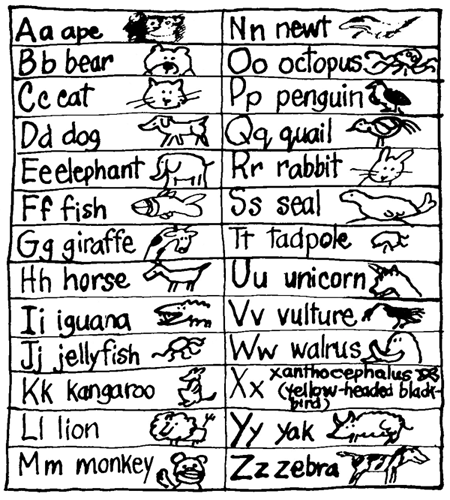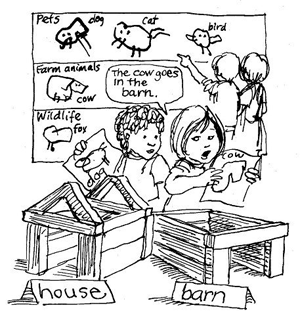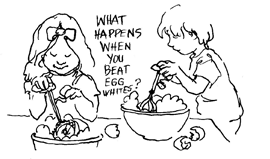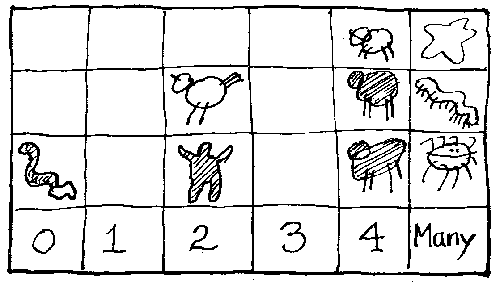|

Chapter Thirteen
Theme: Animals
|
A good month in which to explore this theme is June because children can explore the topic outside. But animals are a good kindergarten topic all year round because children have a special interest in animals. A close look at the theme in June, then, should be the culmination of animal discussions that have taken place all year long, and many of the activities in this chapter can be done in earlier months (in a simpler or somewhat different way), then reviewed and repeated in June with more depth. The theme of animals connects well with the theme of growing up, an important topic for children as they get ready to leave kindergarten and enter first grade. Just as birds leave the nest, so do kindergartners become first-graders!
Language Arts: Oral Language
Changing Words in Familiar Rhymes
Changing words in familiar fingerplays helps children listen to and reproduce sentence patterns.
Two little blackbirds sitting on a hill,
One named Jack.
One named Jill.
Flyaway, Jack.
Flyaway, Jill.
Come back, Jack.
Come back, Jill.
Ask the children to change the animals and their motions. For example, substitute rabbits and hop away.
Two little rabbits sitting on a hill,
One named Jack.
One named Jill.
Hop away, Jack.
Hop away, Jill.
Come back, Jack.
Come back, Jill.
For further variation, change the names Jack and Jill to other names. Help the children hear that the second name has to rhyme with hill. For example:
Two little horses standing on a hill,
One named Mary.
One named Will (or Bill or Phil).
Run away, Mary.
Run away, Will.
Come back, Mary.
Come back, Will.
Language Arts: Listening
Recordings of Animal Sounds
Make tape recordings of animal sounds. Ask the children to think of how many different kinds of animal sounds you could make together. Here are some ideas:
1. Record real animals making sounds at the zoo.
2. Have a Pets Day. Invite parents to come to school in the morning with their children and their pets (in cages, tanks, or on leashes). Make a tape recording of the sounds the pets make.
3. Record children saying the words we have for animal sounds, such as bow-wow for dogs. Ask, Do dogs really say bow-wow?
4. Record the children reciting the following poem (hold up pictures to signal each verse):
Bow-wow, says the dog;
Mew-mew, says the cat;
Grunt-grunt, goes the hog;
And squeak, says the rat.
Tu-who, says the owl;
Caw-caw, goes the crow;
Quack, quack, goes the duck;
And moo, says the cow.
- Author Unknown
Language Arts: Writing
Five-Step Animal Poems
Have the children dictate poems for different animals you study. Explain that the poems do not have to rhyme, but that they do have to sound good and contain interesting words. Each poem has five lines, following a pattern.
Line 1: the name of the animal
Line 2: color and size of animal
Line 3: important body parts
Line 4: what the animal likes to eat
Line 5: the name of the animal (repeated)
For example:
Horse.
Brown and big.
Legs, mane, tail.
Grass, hay, oats.
Horse.
If you like, ask the children to dictate whole sentences for the lines, such as:
I see a cow.
The cow is black and white.
The cow has an udder.
The cow eats grass.
I see a cow.
Write the poems on an experience chart, illustrating each one with a picture to help the children remember it. Make copies of the poems for the children to illustrate, collate, and take home as class poetry books.
Animal Alphabet
Print the alphabet on the board or on a language experience chart, with the children saying the letters are you print them. Then ask them to name animals, one by one. Ask them to see if they can hear the first sound of each name and to tell you the letter that makes that sound. After they figure out the initial letter and sound, have them find that letter on your list. Write the animal's name next to the letter with a little picture or cutout to help the children "read" the name. Keep the animal alphabet project going over a period of days, slowly adding animal names to the list. As the children to think of more animal names for "homework." See if you can find an animal name for every letter of the alphabet.

Social Studies
Habitats
Explain to the children that animals live in different place of "habitats." Some habitats are sky, water (ocean, tidal pools, ponds, lakes), and land (desert, fields, jungle, and forest). With the children cover a bulletin board with different colors of construction paper to represent different habitats. Colors you might use are light blue for the sky (perhaps adding cotton balls for clouds), green or brown (choose a color that best matches your area or use different greens and browns to help the children distinguish between desert, field, jungle and forest areas), and dark blue for water. Have the children draw or cut out pictures of animals and pin them to the board in their habitats. Discuss the various animals and habitats. A good discussion question is: Which animals can go in different habitats? (Geese, for example, can walk on land, swim, and fly.) For a lesson on conservation and animal preservation, add pictures of buildings and roads to the land and ask: How do buildings and roads affect animals' habitats?
Pets, Farm Animals, and Wildlife
The activity above involves classifying animals on the basis of habitat. Another way to classify animals is be their dependence on people. Explain that animals can be divided into three groups: pets, farm animals, and wildlife (animals that live in the wild). Ask the children to look at the habitats bulletin board they made. Ask them to build a house and a barn in front of it with blocks. Then ask them to take off the bulletin board pictures of pets and farm animals and put these animals in the correct place in the new block structures. Discuss the care that pets and farm animals need.

Encourage the children to tell about pets and farm animals they have. To extend the activity, make a graph of pets children have. Children who don't have pets can name the pets they'd like to have or imaginary pets. Keep a class wildlife diary of wildlife observed in the school area.
Invite to class people who work with pets (pet store owners, breeders), farm animals (farmers, ranchers), or wildlife (wildlife officers, park rangers). Have the children show their guests their habitats display, and help the children prepare (ahead of time) questions to ask the visitors.
Eggs and Nests
CONCEPTS: Eggs protect animals before they are ready to be born. Nests protect eggs.
Give the children plastic or paper eggs, asking them to pretend they are real eggs. Show pictures of animals that hatch from eggs (birds, turtles, and some snakes) and of nests. Ask the children to imagine and name pretend animals in their eggs. Provide them with art materials for making nests (string, yarn, twine, grass, clay, cotton balls, and so forth); you may want the children to collect natural nest-making materials outside. Have the children make nests for their eggs. Use box lids or cardboard as bases for the nests. Afterward, display the nests and eggs with labels that tell what's inside. Have the children tell and write stories about their eggs and what happens when the animals inside hatch
If possible, hatch an egg in class. A Chick-U-Bator can be found at education supply companies. Encourage children to bring in read birds' nests that are abandoned by birds or that have fallen to the ground. In class, take apart a read bird's nest together to find out what it's made of and how it's made.

CONCEPT: People eat eggs, but not the ones that are going to hatch into animals.
Ask "How many ways we can cook an egg?" Let the children experiment with egg beaters. Cook eggs on a hot plate or electric frying pan in class. Warn the children to stay away from the heat and the cord.
Science
Classroom Pets
Classroom animals give children the opportunity to observe animals on a day-to-day basis and to experience in a concrete way the needs of animals for shelter, food, and oxygen.
Tropical fish require little care once you have an aquarium established properly. Children can help with the feeding and cleaning of the tank. They can contribute fish to the tank from time to time to learn how fish interact. Ask a local pet store owner to help you set up the tank and to visit the class someday to tell about his or her job.
Parakeets are playful and can be tamed. With patience, some can be taught to talk, an interesting experience for kindergartners. Be prepared to clean the cage often. Again, local pet store owners can be helpful with advice.
Gerbils (also hamsters) are great classroom pets. They need little care-their cage needs to be cleaned only once every several weeks-and a day's feeding is a few tablespoons of gerbil food. If parents are willing to take the offspring, keep a male and female so that you can raise babies-a memorable experience for children. Consult local pet store owners for advice.
Anthills are fascinating to children and allow them to see how communal animals operate. Consider getting a giant Anthill for the classroom. Also, consider a Habitrail, a hamster/gerbil add-on environment; an aquarium set; Critter Condo, a collection of three dome-shaped homes for ants; a chrysalis that transforms into a butterfly; and a miniature tropical forest.
Math
Animals, Math, and Mother Goose
Use these poems as springboards for discussing math and animals. Perhaps make copies of them for the children to illustrate. Encourage the children to memorize the poems.
Hickety, pickety, my black hen,
She lays eggs for gentlemen;
Gentlemen come every day
To see what my black hen doth lay,
Sometimes nine and sometimes ten,
Hickety, pickety, my black hen.
(Use an egg carton and plastic eggs to count out nine and then ten eggs. Use the carton also to introduce the concept of a dozen.)
One, two, three, four, five,
I caught a fish alive.
Six, seven, eight, nine, ten,
But I let it go again.
Why did you let it go?
Because it bit my finger so.
Which finger did it bite?
The little one upon the right.
As I was going to St. Ives,
I met a man with seven wives.
Each wife had seven sacks,
Each sack had seven cats,
Each cat had seven kits.
Kits, cats, sacks, and wives,
How many were going to St. Ives?
(Act this poem out to find out the answer. Have one boy be the man going to St. Ives, another be the man he met and seven girls be the wives. The answer is one. The other eight people and 2,744 cats are going the other way.)
How Big?
Show the children pictures of wild animals and ask the children how big (or small) they think the animals are. Use lengths of yarn to estimate how long and tall each animal is. Label the estimates and tape the strings to the wall. Then find out how long and tall the animals really are by checking in a book about animals or an encyclopedia. Measure the real measurements with yarn and compare with the estimates.
Goldfish 3" long
Prairie dog 14" tall
Orangutan 4 1/2' tall
Kodiak bear 10' tall, standing
Giraffe 19' tall
Blue whale 100' long
How Many?
Ask the children to draw or cut out pictures of animals. Together, make a graph that shows how many legs animals have. The columns on the graph can be: 0, 1, 2, 3, 4, and MANY. Have the children paste their animal pictures on the graph under the right column. Help them discover that some animals have no legs, no animals have one leg, and that many animals have two, four, or many legs. No animals have three legs except for four-legged animals who have lost a leg.

Art
Four Animal Art Projects
1. Wrapping Paper. You can make this by printing on tissue paper with animal cookie cutters dipped in tempera paint.
2. Purple Cows. Paint these to illustrate the poem by Gelett Burgess:
I never saw a purple cow,
I never hope to see one;
But I can tell you anyhow,
I'd rather see than be one.
3. Finger-paint Fish. Paint scales on paper. When dry, cut out fish shapes from the paper. Add eyes with stickers or markers. Decorate a wall or window with the fish. Have the children cut out and add plant shapes at the bottom to give a sense of the ocean floor.
4. Fancy Animal Tails. These are for dramatic fantasies. Provide string, ribbon, yarn, crepe paper, and strips of fabric for the tails. Encourage the children to use their imaginations to make the tails realistic or fanciful. Show them techniques for braiding tails and gluing on feathers and/or glitter.
Papier-Mâché Animals
Plan several days for this project. On day one have the children build animals from junk sculpture materials: plastic containers, boxes, tubes, egg cartons, Styrofoam peanuts, and so forth. Have them build the animals on box lids turned upside down for bases. The animals can be realistic or imaginary. On day two make papier-mache as follows: Mix flour and water to the consistency of thick cream. Cut or rip newspapers into strips one inch by six
-inches. Work on tables covered with newspapers. Show the children how to dip a strip of cut paper into the flour/ water mixture and then pull it between two fingers to remove most of the moisture. Lay the strip on the sculpture. Continue to do this until all of the sculpture is covered with several layers of papier-mache. Dry thoroughly and paint with poster paint. Label the bases with the animals' names, and tell or write stories about them.
Music
The Bear Went over the Mountain
The bear went over the mountain,
The bear went over the mountain,
The bear went over the mountain,
To see what he could see.
The other side of the mountain,
The other side of the mountain,
The other side of the mountain,
Was all that he could see.
Dramatize the song to music. Split the children into two groups and have them stand at opposite sides of an open space. Have one group of children sing "The Bear Went over the Mountain" as they pretend to march over a mountain in a line. When they finish singing both verses, they freeze. At this point, you suggest a new verse, such as, "The bear saw robins." At this point the other group of children imitate robins for the marchers to observe. The "robins" sing:
The bear saw robins,
The bear saw robins,
The bear saw robins,
Robins he could see.
At the end of their verse, the marchers and robins return to the opposite sides of the room, and you start over again, switching sides. The robins become the marchers, and the marchers become the next group of animals you name.
Imitate Animal Movements
There are many ways to classify animals. Ask the children to think of the different ways: by habitat, by their relationship to people (pets, farm animals, wildlife), by size, by color, and by movement. The children are likely to think of more ways-good! Encourage them to continue to think of ways, and use some of the methods they suggest to classify classroom animal pictures and models.
Movement activities can be used to supplement or even introduce the question: How many different ways do animals move? Secretly, show pairs of children animal toys or pictures and ask them to imitate these animals to music for the rest of the children. Ask the watchers to guess the animals.
Make your own class tape of animal songs, such as "Old MacDonald Had a Farm," "I'm Bringing Home a Baby Bumblebee," "Eentsy Weentsy Spider," "Shoo Fly," "Mary Had a Little Lamb," "Over in the Meadow," "Pop Goes the Weasel," "I Know an Old Lady Who Swallowed a Fly," "Five Little Ducks," and "Bingo." If possible, make a songbook with the words to these songs for the children to take home and sing with parents. Have the children illustrate the songbook.
Physical Education
Run, Rabbits, Run!
Pick one or two children to be "foxes" or other predators. They go and sit in a "foxhole" at the far end of the playing area, with their backs toward everyone. The rest of the children are "rabbits" or other prey. The rabbits line up at the opposite end of the playing area, facing the backs of the foxes. When you yell, "Rabbits, go eat," the rabbits creep across the playing area toward the foxes. When you yell, "Run, rabbits, run!" the foxes jump up and chase the rabbits back to their starting line. Any rabbits who are caught by foxes become foxes. The last rabbit left can take your place, giving the commands "Rabbits, go eat" and "Run, rabbits, run!"
CONCEPTS TO DISCUSS: Some animals eat other animals. These animals are called predators. The animals who are eaten are called prey. Some animals eat animals and plants, and others eat only plants. What animals eat is yet another way to classify animals.
Pin the Pocket on the Kangaroo
Discuss the body parts of different animals in class, using pictures and models of animals. Compare animal body parts with human body parts, reviewing the names of people's body parts. Have the children think of different ways to play Pin the Tail on the Donkey. For example, they might want to play Pin the Pocket on the Kangaroo, Pin the Trunk on the Elephant, or Pin the Tusk on the Walrus. Have them paint animal pictures to use in the games.
CONCEPT TO DISCUSS: Animals have different body parts.
Physical Education
Bull's-Eye Toss
Use a real bull's-eye target or make one with concentric circles. Assign points to the circles. Have the children take turns throwing little balls of Fun-tak at it. The Fun-tak will stick to the target so you can see where it lands and how many points are earned. Don't bother to keep score; that makes the game too competitive for kindergartners. Just let them throw, say how many points they earned that time, and move on to the next player. Remove the Fun-tak ball each time. Have the children stand near enough to the target that they earn points most of the time.
CONCEPT TO DISCUSS: A bull's-eye is a design that looks like the round part of an eye. It is made up of circles. The inside circle is the hardest one to hit and so is worth the most points.
Fish for Presents
This is a good game to play at holiday time or at the end of the year, when you might want to give each child a present for going on to first grade. The present might be a pencil, pad, crayons, or small book. To make the "fishing pole," tie a string to a yardstick. At the other end of the string, attach a hook bent from a paper clip. Wrap the presents in tissue paper and ribbon, leaving "catchable" bows on the ribbons. To play, each child "fishes" for his/ her present
|

